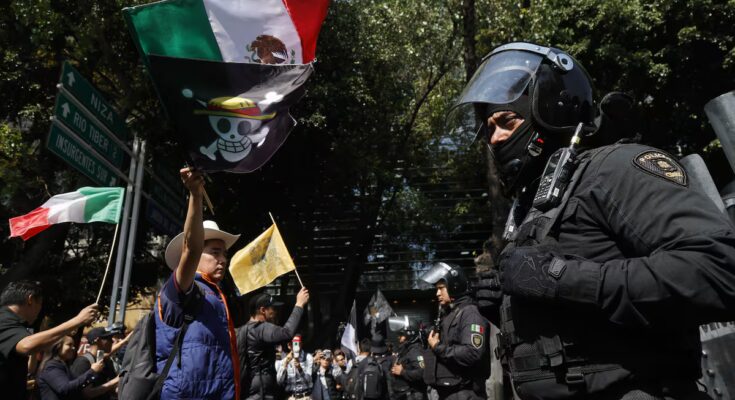The strong protests that brought together around 17,000 people against the Morena government on Saturday echoed this Thursday to other times. The rerun, convened at the same time as the Ángel de la Independencia and the Ciudad Universitaria, in the Mexican capital, barely managed to exceed a hundred participants in the first event and none in the second. The march was intended to counterschedule the military parade marking the 115th anniversary of the Mexican Revolution, but low turnout and a police cordon prevented the event from becoming significant. The demonstration took place like one of the many that took place in the city, without clashes with the police and with a minimal presence of young people, who in theory would have called to protest under the aegis of Generation Z.
Activist Pablo Ortiz Padilla, 52, led, megaphone in hand, a protest where demonstrators were a minority. The police contingent – of around 80 elements in the now roundabout of women who fight (Colón), in Reforma, the first point of the blockade – and the civilian staff of the Ministry of the Interior of the capital – around 50 – were equal in number to those present, almost all over 30 years of age. Spectators and the press completed a desolate landscape, compared to what was experienced days ago, in the self-proclaimed marches of Generation Z, which left behind them a trail of violence that is absent today.
“(The low turnout) is the result of the fear they have instilled in people,” Padilla justified on more than one occasion. The slogans that accompanied the march ranged from “my voice is not disorder, it is right”, to “respect yes, repression no”, to “PAN, PRI, Morena: the same shit”. They were all aimed, however, against the party in power, the only common point of those who came this morning. “Morena out!” it was the most repeated thing.
The only young man in sight around 11am, now that he marked the start, was carrying two signs related to environmental causes. “I come to publicize the cases of ecocide and the defenders who have been murdered,” said activist Ángel Negrete, 23, who had coordinated via Discord with three other young people he did not find at the scene. This time the furor on the networks was not the prologue to the response in the streets.
A few meters away from him, a group of four adults – Jorge, Carlos, Silvia and Marta: the youngest was 62, the oldest 78 – were calling for the dismissal of Claudia Sheinbaum, dissatisfied with the recall scheduled for 2027, in the medium term. “We don’t want to be Cuba or Venezuela. We want freedom,” they expressed unanimously: “We don’t want this government, it’s the most corrupt we’ve ever had.” The possible replacements for this group come from the names that have been flying since Saturday during the week: the entrepreneur Ricardo Salinas Pliego, who capitalizes on the protests with more force, the panists Ricardo Anaya or Lilly Téllez, and the mayor of Cuauhtémoc, the PRI member Alessandra Rojo de la Vega. “There you have to choose, anyone would be better,” one of them underlined. The themes were repeated here and there: insecurity, corruption, lack of medicine and freedom.
At the roundabout of the women fighters, the hundred demonstrators met the first contingent of police, who blocked their passage, waiting for the march to end. The Mexico City Dialogue and Coexistence Group, created specifically for these protests, formed a cordon of orange vests that separated the large group of officers from the protest participants, especially those who were raising their voices. The unusual image of a civilian body in front of the security forces sought to avoid at all costs a repeat of Saturday’s clashes, which left 100 police officers and 20 civilians injured. The leaders of the capital’s Secretariat were there to extinguish any spark of provocation that could cause the meeting to explode. His intervention was not necessary.
The cordon was dissolved an hour and a half later, when the march was over, so that the protest could advance towards the Zócalo, escorted on both sides by a black mass of officers advancing simultaneously. The second contingent of elements met them at the intersection of via Palma and via 5 de Mayo, the closest point to the public square that they managed to reach. Shortly thereafter, the protests dissolved, overwhelmed by fatigue and a lack of expectations. The support for Claudia Sheinbaum has not found, at least today, an opposite equivalent on the streets of the capital. Social unrest, however, is still present.



